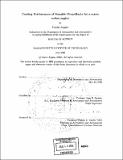| dc.contributor.advisor | Alan H. Epstein. | en_US |
| dc.contributor.author | Joppin, Carole, 1979- | en_US |
| dc.contributor.other | Massachusetts Institute of Technology. Dept. of Aeronautics and Astronautics. | en_US |
| dc.date.accessioned | 2005-08-24T20:35:17Z | |
| dc.date.available | 2005-08-24T20:35:17Z | |
| dc.date.copyright | 2002 | en_US |
| dc.date.issued | 2002 | en_US |
| dc.identifier.uri | http://hdl.handle.net/1721.1/8130 | |
| dc.description | Thesis (S.M.)--Massachusetts Institute of Technology, Dept. of Aeronautics and Astronautics, 2002. | en_US |
| dc.description | Includes bibliographical references (p. 211-213). | en_US |
| dc.description.abstract | This thesis studies the selection of propellants for a liquid regeneratively cooled micro rocket engine focusing on the characterization of their cooling performance. Propellants will be at high pressures and under high heat fluxes in the cooling passages and will be supercritical. A summary of the propellant combination selection process and a brief evaluation of potential propellants are presented. A series of heat transfer tests in electrically heated stainless steel micro tubes 95 microns inner diameter has been conducted with two hydrocarbons JP7 and JP10 at subcritical, critical and supercritical conditions and under high heat fluxes. JP7 and JP10 have been evaluated on the basis of their heat transfer capabilities, their stability and the formation of deposits in micro channels. JP7 offers a high heat capacity. An increase in the heat transfer coefficient at the end of the tube, combined with an increase in the Stanton number, seems to indicate that JP7 undergoes an endothermic decomposition which causes a significant enhancement in heat transfer capacity. JP10 offers lower heat transfer coefficients. Both hydrocarbons show a good stability and no evidence of deposits has been seen. Previous results with supercritical ethanol were compared to the results with JP7 and JP10. JP7 seems to provide the highest heat transfer coefficients at high pressures and seems to be the most promising coolant for the regeneratively cooled rocket engine. Compatibility issues associated with the use of hydrogen peroxide as oxidizer for the liquid rocket engine have been addressed. Materials used in MEMS devices show good compatibility with 98 % hydrogen peroxide after passivation in 30 % hydrogen peroxide except for platinum. | en_US |
| dc.description.statementofresponsibility | by Carole Joppin. | en_US |
| dc.format.extent | 213 p. | en_US |
| dc.format.extent | 15038587 bytes | |
| dc.format.extent | 15038346 bytes | |
| dc.format.mimetype | application/pdf | |
| dc.format.mimetype | application/pdf | |
| dc.language.iso | eng | en_US |
| dc.publisher | Massachusetts Institute of Technology | en_US |
| dc.rights | M.I.T. theses are protected by copyright. They may be viewed from this source for any purpose, but reproduction or distribution in any format is prohibited without written permission. See provided URL for inquiries about permission. | en_US |
| dc.rights.uri | http://dspace.mit.edu/handle/1721.1/7582 | |
| dc.subject | Aeronautics and Astronautics. | en_US |
| dc.title | Cooling performance of storable propellants for a micro rocket engine | en_US |
| dc.type | Thesis | en_US |
| dc.description.degree | S.M. | en_US |
| dc.contributor.department | Massachusetts Institute of Technology. Department of Aeronautics and Astronautics | |
| dc.identifier.oclc | 51720009 | en_US |
